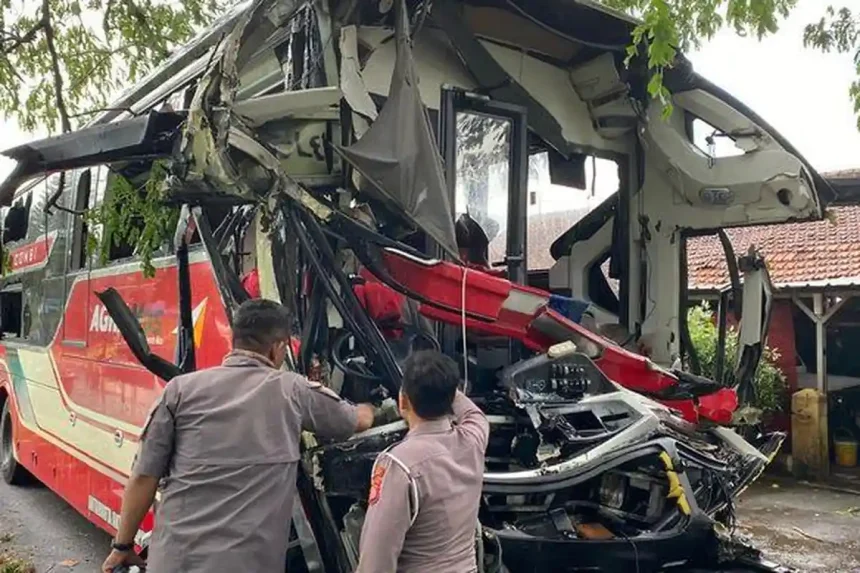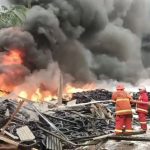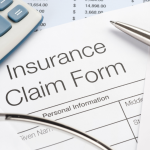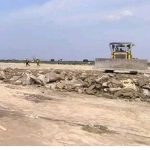A series of major accidents that have occurred in various regions in recent days—from shophouse and shopping center fires, warehouses destroyed by gas leaks, ships catching fire and sinking, to fatal collisions on toll roads—demonstrate the increasing complexity of risks in the industrial, transportation, maritime, and commercial property sectors. Each incident occurs due to a combination of factors: operational negligence, unsafe electrical installations, overloading, driver fatigue, and weak compliance with safety standards. Through the following risk analysis summary, we provide a comprehensive overview of the root causes, recurring vulnerabilities, and relevant insurance coverage recommendations so that business owners, transportation operators, building managers, and maritime stakeholders can strengthen their risk management before major losses occur.
A shophouse and cafe in Kota Tua catches fire! Overloaded cables trigger the blaze, causing losses of up to Rp136 million.
A cafe shophouse on Jalan Kunir Raya, Pinangsia, Tamansari, West Jakarta, was completely destroyed by fire on Tuesday night. According to the West Jakarta Fire and Rescue Agency (Gulkarmat), the fire is suspected to have originated from an overloaded lamp cable. Six fire extinguishers with 30 personnel were deployed to extinguish the fire, which burned around 45 m² of the three-story building. Residents saw the fire from the rear of the building and immediately informed the shophouse tenant, Ngadiyon (59), who tried to extinguish it with a fire extinguisher but failed because the fire was too big. Total losses are estimated at around Rp. 136 million, with one family affected.
Risk Accident Review
This cafe shophouse fire highlights the high risk in commercial buildings with dense electrical installations, especially if the wiring is substandard or overloaded. Overloaded lighting cables triggered a rapidly expanding spark, exacerbated by the flammable materials in the shophouse. The failure to extinguish the fire initially indicated the lack of protective systems such as smoke detectors or fire suppression. The impacts of the risk include property damage, business interruption, potential loss of life, and financial loss to both owners and tenants. This incident underscores the importance of regular electrical inspections, installation of fire protection systems, and training in the use of fire extinguishers.
Types of Insurance Required:
- Property All Risks Insurance– Protect the cafe building, interior and equipment from fire damage.
- Fire & Allied Perils Insurance– Basic protection against fire and short circuit risks.
- Business Interruption Insurance– Covering revenue losses due to cafe operations being halted.
- Contents Insurance– For the protection of stock, furniture and assets belonging to the tenant.
- Tenant Liability Insurance– Protects tenants from claims if proven negligent.
- Personal Accident Insurance– For residents or workers affected during the incident.
Luwes Supermarket in Ungaran Nearly Burns Down Due to Overheating Chimney
A fire broke out at Luwes Supermarket on Jalan Brigjen Sudiarto, Ungaran, Semarang Regency, on Wednesday (November 19, 2025) at 2:00 PM WIB. The fire broke out on the fourth floor, near the food court’s smoke exhaust. Despite causing panic, the supermarket remained open.
West Ungaran Police Chief, AKP Sugiyarta, explained that there were no fatalities. The fire was extinguished by security personnel, police, and firefighters who quickly arrived at the scene.
The incident began when a chimney overheated due to heavy cooking activity. The heat ignited a pile of waste paper nearby, causing it to catch fire. The fire caused only minor damage to the walls and did not disrupt store operations.
Risk & Accident Review
The fire incident at Luwes Supermarket highlighted weaknesses in commercial kitchen risk management, particularly regarding the management of chimneys and surrounding combustible materials. An overheated chimney due to intensive cooking activities ignited a pile of waste paper placed too close to the heat source. This highlights the importance of regular chimney inspections, temperature control, cleaning the kitchen area, and managing flammable materials. The swift response by security, the National Police, and the Fire Department prevented major damage and loss of life. A thorough evaluation is needed to strengthen safety SOPs and prevent a recurrence.
Types of Insurance Needed
- Property All Risks (PAR)– Protect supermarket buildings, equipment and assets from fire risks.
- Business Interruption (BI) – cover potential losses if operations are halted due to fire.
- Fire Insurance– Basic protection specifically for fire and explosion risks.
- Public Liability Insurance– Protects against third party claims resulting from incidents in the operational area.
- Kitchen/Restaurant Risk Extension– Additional protection for risks to the kitchen, chimney, and cooking equipment.
Gas Leak Triggers Massive Fire! Furniture Warehouse in Banyuwangi Completely Burns
A major fire engulfed a household equipment warehouse belonging toMohammadNur on Jalan Udang Windu, Banyuwangi, Wednesday (11/19/2025). Approximately 40% of the building and warehouse contents were destroyed after an LPG gas tank used for cooking allegedly leaked and ignited a fire.
The warehouse, normally used for storing furniture and parking cars, had been temporarily converted into a kitchen while the main kitchen was being renovated. While the owner’s wife was cooking for the workers, a fire suddenly broke out, spreading rapidly through the warehouse’s wooden structure.
Residents and students from nearby schools helped extinguish the fire and evacuate two cars before they could catch fire. The Banyuwangi Fire Department deployed three fire engines and managed to extinguish the blaze in 45 minutes. There were no casualties, but losses are estimated at tens of millions of rupiah.
Risk & Accident Review
This fire demonstrates the high risk of converting an area not designated as a kitchen for cooking. An LPG gas leak quickly ignited the fire, especially since the warehouse was made of wood and contained numerous flammable materials. Lack of ventilation, the absence of a gas detection system, and the storage of flammable materials accelerated the fire’s spread. The evacuation of two cars demonstrated the potential for significant losses if residents had responded more slowly. This incident underscores the importance of SOPs for gas use, cylinder inspections, fire safety awareness, and the separation of kitchen areas from storage areas.
Types of Insurance Needed
- Property All Risks (PAR)– Protect buildings, vehicles and warehouse furniture from fire damage.
- Fire Insurance– Basic protection for fire risks caused by LPG gas.
- Business Interruption (BI)– Cover losses due to cessation of activity or damage to facilities.
- Public Liability Insurance– Handling potential claims from third parties, especially due to the location near the Islamic boarding school.
- Motor Vehicle Insurance– Protecting two cars that were threatened with fire.
Boat BlueRayA ship caught fire after its engine exploded while loading coal in South Kalimantan.
The joint SAR team successfully evacuated 21 crew members (ABK) of the KM BlueRay ship which caught fire while the ship was anchored and carrying out the coal loading process in the waters of Tanjung Pemancingan, Kotabaru, South Kalimantan.
The fire was reported on Tuesday evening, November 18, 2025, at approximately 8:30 PM WITA, and originated in the engine room. Initial information was relayed by the ship’s agent, PT IDT, to the relevant authorities, before being followed up with the Kotabaru SAR Post and the Banjarmasin SAR Office.
The SAR team departed in RIB 02 and, after coordinating with the captain and the ship’s agent, confirmed that all crew members were safe and there were no casualties. The fire in the engine room was brought under control, and the entire crew remained on standby on board while awaiting further instructions.
Risk Accident Review
Fires in a ship’s engine room pose one of the highest risks in the operation of vessels transporting commodities such as coal. Loading activities, coupled with hot engines, increase the potential for ignition points. Delays in initial detection could potentially trigger major damage to the propulsion system and endanger the entire crew. Rapid coordination between maritime stakeholders was a key factor in the rescue of the 21 crew members. However, this incident demonstrates the importance of routine engine room inspections, fuel installation maintenance, adequate fire extinguisher availability, and standard evacuation procedures to prevent total losses or fatal accidents.
Types of Insurance Needed
- Marine Hull & Machinery (H&M)– Protects against damage to the ship, including engine room fires.
- Protection & Indemnity (P&I) Insurance– Guarantees the risk of legal liability to crew members, the environment, and third parties.
- Cargo Insurance (Coal)– Covers potential damage or loss of cargo during the loading process.
- Crew Personal Accident / Crew Welfare Insurance– Protection for accidents or injuries for all crew members.
- Marine Liability Insurance– For additional risks when the vessel is operating in a port area or restricted waters.
Cement-laden Ship Sinks in Mahakam River, Killing 8
A pontoon boat carrying cement and a number of workers sank in the Mahakam River, West Kutai, East Kalimantan. In this tragic incident, 20 people were rescued, while eight others were found dead.
The incident occurred on Monday (10/11) at around 20.00 WITA, right after the ship finished loading cement in Linggang Muara Leban Village to be taken to the company’s location in Ujoh Halang Village.
Shortly after sailing—about 150 meters from the riverbank—water began to enter the ship’s hull. Preliminary suspicions suggest the ship sank due to overloading.
The SAR team found seven victims on Tuesday (November 12), and the final victim was found dead on Thursday (November 13) evening. All bodies have been evacuated to Harapan Insan Sendawar Hospital.
Risk Accident Review
The sinking of a pontoon boat in the Mahakam River demonstrated weak safety controls in the loading and operation of river vessels. Overloading was a major factor accelerating water ingress into the hull and causing loss of stability. Nighttime conditions also reduced visibility, delaying hazard detection. A lack of evacuation procedures and safety equipment contributed to the high death toll. This incident underscores the importance of monitoring load loads, calculating freeboard, mandating the use of life jackets, and ensuring operational seaworthiness certification for all river working vessels to prevent similar tragedies.
Types of Insurance Needed
- Marine Hull & Machinery Insurance
Covers damage or loss of pontoon boats due to sinking. - Protection & Indemnity (P&I) Insurance
Guarantees legal liability for loss of life, injury, and third party claims. - Crew Personal Accident / Marine Crew Insurance
Life and accident protection for workers/crew members on board the ship. - Cargo Insurance
Cover damage or loss of cement cargo that sank. - Employer’s Liability Insurance
If the worker is an employee of the company, this policy protects against the risk of injury/death in an employment relationship. - Third Party Liability (TPL) Marine
If the sinking of the ship causes environmental impacts or damage to the assets of other parties in the waters.
Source: https://news.detik.com/berita/d-8209939/kapal-pengangkut-semen-di-kaltim-tenggelam-8-orang-tewas
Fatal Bus Collision on Cipali Toll Road Leaves 3 Vehicles Destroyed, 5 Dead, and 21 Injured
A tragic accident occurred at kilometer 72,600 of the Cipali Toll Road heading towards Jakarta early Tuesday morning (November 18, 2025), involving two buses and a minibus. The incident, which occurred at around 2:15 a.m. Western Indonesian Time (WIB), killed five people, seriously injured seven others, and sustained minor injuries to 14 others.
According to the Head of Traffic at Purwakarta Police, AKP Muthia Khanza, the exact cause of the accident is still being investigated through witness examinations and crime scene processing.
A Daihatsu Gran Max traveling from Cirebon to Jakarta allegedly suddenly changed lanes and was hit by an Agra Mas bus that failed to maintain a safe distance. The impact sent the Gran Max flying and hitting the Sinar Jaya bus. All three vehicles sustained severe damage, with the Agra Mas bus crossing the road, the Gran Max coming to a stop on the shoulder, and the Sinar Jaya bus plunging into a ditch.
The victim is currently at Abdul Radjak Hospital in Purwakarta, and the case is being handled by the Purwakarta Police Traffic Accident Unit.
Risk Accident Review
This multiple accident on the Cipali Toll Road demonstrates the high risks on high-speed toll roads, particularly related to sudden lane changes, inadequate safety distances, and driver response in early morning conditions. Fatigue is a likely contributing factor. The impacts of the accident include total vehicle damage, multiple injuries, potential large claims, and disruption to bus company operations. Improved risk management is needed through defensive driving training, GPS and speed monitoring, driver shift management, and regular vehicle inspections. Road infrastructure must also support adequate warning signs and lighting.
Types of Insurance Required:
- Commercial Motor Vehicle Insurance
Covers total/partial damage to buses and minibuses. - Passenger Liability Insurance
It is mandatory for public transportation to protect passengers from injury, disability, or death. - Third Party Liability (TPL)
Protects bus companies from third party claims resulting from damage to other vehicles or road users. - Personal Accident Insurance
For drivers and crew who are injured or die. - Business Interruption Insurance
INfor bus operators who experience operational losses because the fleet cannot operate.
Source : https://www.metrotvnews.com/read/NA0CEV02-kecelakaan-maut-di-tol-cipali-km-72-lima-tewas
Brake Failure on Bawen Downhill! Truck Hits 4 Cars, Injuring 4 People
A multiple-vehicle accident occurred at the Bawen Toll exit in Semarang Regency when a box truck lost control due to suspected brake failure. Traveling from Ungaran to Salatiga, the truck failed to stop at a red light and struck four cars parked in front of it.
Four drivers sustained injuries and were immediately taken to the hospital for treatment. The truck, which was parked across the roadway and completely blocked the road, caused a traffic jam. Semarang Police Traffic Unit officers evacuated the vehicles, and the investigation is ongoing.
Risk Accident Review
This incident demonstrates the high risk on downhill roads, especially for heavy vehicles that rely on optimal braking systems. Suspected brake failure is a key factor highlighting the need for regular inspections, brake pressure checks, and adequate brake cooling systems for long downhill roads. The location of traffic lights on downhill roads also increases the risk of collisions if a vehicle malfunctions. The impacts are widespread, ranging from injuries to total gridlock. Implementing standard operating procedures (SOPs) for pre-trip inspections, use of slow lanes, and emergency escape lanes are essential to prevent similar accidents.
Types of Insurance Needed
- Commercial Vehicle Insurance (Truck Vehicle Insurance)
Protects against truck damage due to accidents. - Third Party Liability (TPL)
Covers damage to 4 other cars as well as third party claims. - Personal Accident Insurance
For drivers and passengers of vehicles who suffer injuries. - Cargo Insurance
If the truck is carrying a load that is damaged due to the impact. - Employer’s Liability Insurance
If the driver is an employee of the transportation fleet. - Road Accident Liability Extension
Increases protection if an accident causes traffic disruption and public loss.
This cluster of incidents reveals a fundamental pattern that cannot be ignored: operational risks in Indonesia are increasing and often not being addressed systematically. Substandard electrical installations, weak load monitoring, non-compliance with safety SOPs, and a lack of regular inspections contribute to the recurring occurrence of incidents such as fires, traffic accidents, and ship engine failures. Without strengthened risk management and proper insurance coverage, companies face the potential for significant financial losses, operational disruptions, lawsuits, and even loss of life. Therefore, every business—whether property owners, ship managers, transport operators, or the logistics industry—needs to ensure robust safety structures, regular risk audits, and comprehensive insurance coverage as a foundation for business continuity. Ultimately, proper preparedness and mitigation not only protect assets but also safeguard the safety of many people.
—
DON’T WASTE YOUR TIME AND SECURE YOUR FINANCIAL AND BUSINESS WITH THE RIGHT INSURANCE.
HOTLINE L&G 24 JAM: 0811-8507-773(CALL – WHATSAPP – SMS)
Website: lngrisk.co.id
Email: halo@lngrisk.co.id
—













